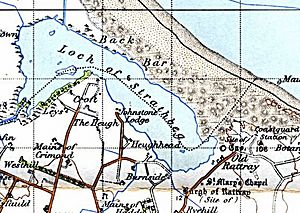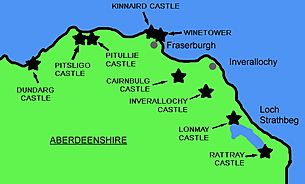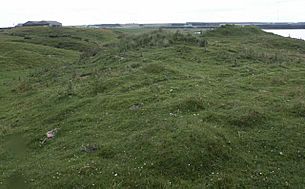Castle of Rattray facts for kids
Quick facts for kids Castle of Rattray |
|
|---|---|
| Rattray, Aberdeenshire, Scotland | |

The castle shown on a 1931 Ordnance Survey map as "Site of Cas" to the south-east of Loch Strathbeg.
|
|
| Coordinates | NK088578 |
| Site information | |
| Owner | Comyn family (early 13th to early 14th centuries) |
| Condition | Destroyed, no remains. |
| Site history | |
| Built | 12th century |
| In use | 12th, 13th and early 14th centuries. |
| Materials | originally timber, then stone. |
| Demolished | timber structure likely 1308, stone unknown. |

The Castle of Rattray was an old Scottish castle that changed its look many times over about 600 years. It was first built around the late 1100s or early 1200s. This first castle was a motte, which is a type of castle built on a raised earth mound. It helped protect the harbour and the village of Rattray.
Later, between 1214 and 1233, a powerful family called the Comyns upgraded the castle. But in 1308, this timber castle was destroyed during a time of war called the Harrying of Buchan. After it burned down, a stronger stone castle was built in its place. Sadly, this stone castle and the nearby village were buried by a huge sandstorm in 1720. The castle was never dug out and remains hidden under the sand today. Experts like W. Douglas Simpson called it one of the "nine castles of the Knuckle". This name refers to the rocky coastline of north-east Aberdeenshire.
Contents
Where Was Rattray Castle Located?
The Castle of Rattray was built on a spot called Castlehill. This hill was on the south side of an estuary, which is where a river meets the sea. This estuary flowed into Strathbeg Bay. Another castle, Lonmay Castle, protected the north side of the bay. The castle was right next to a sheltered harbour. It even had an entrance that faced the harbour.
Originally, Castlehill was very close to the sea. But over time, shifting sands have changed the coastline a lot. Today, Castlehill is about a mile inland. You can still see it as a grassy, oval-shaped mound. It rises about 11.6 metres (38 feet) above the nearby flat land.
The First Castle: A Timber Fort
The very first building on Castlehill was a small timber (wooden) castle. It was built in the 12th century, during the late Middle Ages. Its main purpose was to protect the important estuary.
The Comyn Family's Castle
In the 13th century, the Castle of Rattray became the main home of the Comyn family. They were powerful nobles known as the Earls of Buchan. William Comyn, who became Earl of Buchan in 1214, improved the castle. We don't know if he just added to the old wooden castle or built a completely new one. He did build a grand "manor house" with a timber-framed hall. He also built a private chapel, St Mary's Chapel, in Rattray village.
Around the mid-1270s, the castle was made even stronger. However, the Comyn family's castle was destroyed in the summer of 1308. This happened during the Harrying of Buchan. Robert the Bruce and his brother Edward attacked the Comyn lands after John Comyn, Earl of Buchan lost the Battle of Barra. The wooden Rattray Castle was likely burned to the ground and left in ruins.
The Stone Castle and Its Fate
After the timber castle was destroyed, a new stone castle was built on the same spot. This stone castle continued to protect Starnie Keppie harbour and Rattray village.
Over the years, the ownership of the castle and lands changed hands many times. After the Harrying, the Earldom of Buchan was divided. Later, Robert the Bruce gave the "lordship of Rattray" to Sir Archibald Douglas in 1324. In 1382, Alexander Stewart became the Earl of Buchan.
In 1563, Mary, Queen of Scots, declared Rattray a Royal Burgh. This meant it had special rights, like a town. However, it seems these rights didn't last very long.
The stone castle and the village were eventually buried by a huge sandstorm. A local story says this happened during a great storm in 1720. The storm cut off Strathbeg Bay from the sea. The story claims the castle was covered in sand one Sunday evening while the people inside were playing cards. They were supposedly "buried alive." Another less likely story says the site was buried because of the plague.
What's Left Today?
Today, there isn't much to see at the castle site. The remains have been covered by deep soil for a long time. Around 1730, people digging on the south-east side of Castlehill found many stones. They thought these might have been part of the castle's kitchen, as they found large hearth-stones covered with ashes.
Other items found include silver coins and two kiln stands. These stands were found in 1829 and are now kept at the Marischal Museum in Aberdeen. There's also a story about a man in 1740 who was suffocated by sand when his spade went through a door panel. A well-made causeway (a raised road) was also found at the foot of the mound where the castle is believed to be buried.
Modern Discoveries: Excavations
Between 1985 and 1989, archaeologists carefully dug up parts of Castlehill. These excavations (digs) uncovered the remains of the stone castle. They also found clues about the earlier timber castle. The stone castle had a "perimeter wall" and two buildings inside. It was about 20 metres long and 6.5 metres wide. It was divided into three rooms. The thick walls suggest it might have had more than one floor.
You can read more about these discoveries in a detailed article called "Excavations at Rattray, Aberdeenshire. A Scottish deserted burgh." This article was written by Murray & Murray and is a very important source for historians and archaeologists.
Rattray Artifacts Today
Today, Aberdeen City Council keeps many artifacts found at Rattray and the Castlehill site. Some of these items have been shown in temporary displays at places like James Dun's House in Aberdeen.


